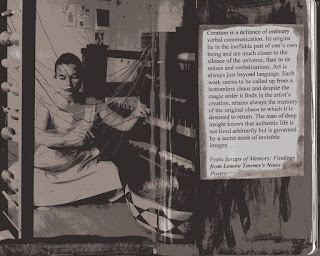
°
It took a while for the sender's name to sink in: Lenore Tawney. Tawney? Why, it was my dad's second name (but the one he went by); my second middle name; my elder daughter's middle name. Tawney, Tawney, Tawney. But who was this Lenore Tawney?

°
Turns out she is the 'mother' of textile art - working away with threads and looms before Eva Hesse was tying her shoe laces (born in 1907 Tawney lived to be 100). How had I never encountered her, her name, her work before? The textile pieces aside, her collages are outstanding - the best, I feel, using the fewest materials as seen in the envelopes and postcards.
And there's a further coincidence. Who wrote an insightful piece on Tawney's work but one James Schuyler ...
"Colors of time passing - old sheet music, foxing, scorch, Gothic print, weathering, and water stains - intergrade with the aliveness, or the freshness, of raw wood, new paper, linen, white porcelain (cups holding bits of eggshell: a fine distinction); as in a spice or herb chest, labeled and out of date, with white and black peppercorns (which are neither white or black). Time, of different moments and of different sorts, is brought together and made tangible: the time it took to make the cabinet and for it to age, another kind of time that is the cycle of a peppercorn growing into a tree and producing more peppercorns; a cycle that extends its potential into a future beyond the viewing.
And sometimes she cancels time with a sky-blue wash."
(Great last sentence - just ripe for a Schuyler poem)
And so it's back into the notebooks trying to make sense of the power her images release. And those photographs of her at work: head in hand pulling absent-mindedly with a thread, or cross-legged at the loom - is it just me or she looks like a younger more severe Bjork? And the loom like some Harry Partch-type musical contraption. And those suggestive pictures tacked on the wall ... Clotho (the spinner) ... Lachesis (the drawer of lots) ... Atropos (the inevitable) - the Moirai ...
°
Or, as Tawney herself phrased it:
Creation is a defiance of ordinary verbal communication. Its origins lie in the ineffable part of one’s own being and are much closer to the silence of the universe, than to its noises and verbalizations. Art is always just beyond language. Each work seems to be called up from a bottomless chaos and despite the magic order it finds in the artist’s creation, retains always the memory of the original chaos to which it is destined to return. The man of deep insight knows that authentic life is not lived arbitrarily but is governed by a secret mesh of invisible images.
(From Scraps of Memory: Findings from Lenore Tawney's Notes: Poetry)
And as if that wasn't enough ...
°
... it was yesterday that I woke up to Miroslav Tichy's work (you'll have to forgive the missing accent on the 'y'). Judging by photographs such as those above, in his eighties he looked like a cross between Keith Waldrop and Robert Wyatt. The images he produced with his bizarre self-made equipment are astonishing and disturbing by turns - disturbing because although you hadn't seen them before (or had you?) they seem vaguely familiar. Out-of-focus and deliberately distressed, the faces and figures become half-remembered as if in some strange way you could squint your inner eye and turn the lens of memory and suddenly it would all become clear. Kundera-esque moments of longing and forgetting. Disturbing, too, for their subject matter - the kind of thing that would lead to confiscation of a hard disc or a cabinet minister's abrupt resignation. Or maybe not that bad - but going that way. Dodgy, for sure, in these days of paranoia and political correctness. (One wonders at the circumstances under which the pictures were taken - or was it simply accepted in the neighbourhood that a shabby-looking man was hanging out by the swimming pool? "Who's that, Irina, standing behind the fence? ...").
And - damn it! wouldn't you know - Geof Dyer's written a good essay on Tichy. I particularly like the phrase 'stone-age photographer' and his re-situating of a quotation by Michael Pisaro:
"It's almost as though he has discovered a language or, better, has heard of a language: heard about some of its vocabulary, its grammar and its sounds, and before he can comprehend it, starts using this set of unformed tools to narrate the most important event of his life".
Originally about Dylan, it works beautifully for Tichy.
Another of those questions that dog me: why does Geof Dyer always get there first?
°
And so we continue, discovering further reasons to continue ... Have a good Sunday.




1 comment:
I find it difficult not to love Tichý (excuse, if you will, the pedantry of the diacritic), and it is the roughness of his art, the near-constant perversity of his vision, and the clear unhingedness of his self that make this so.
Quite a free-wheeling blog entry you have here this day, Jonathan.
And another Geof wrote about Tichý? (There are so few of us.)
Geof
Post a Comment